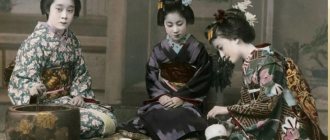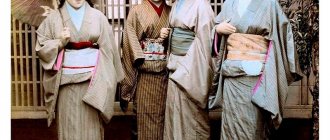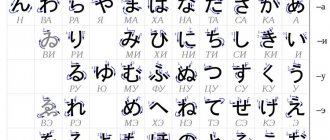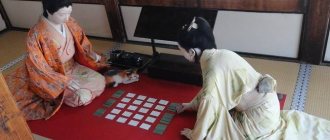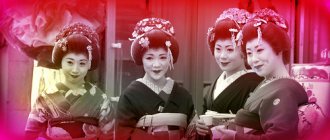All Japanese schoolchildren, except the youngest, are required to wear a uniform. Moreover, each school has its own uniform. But in reality there are not so many options: for girls it is either an English-style suit with a checkered skirt, or just a plain skirt, as well as white blouses, sweaters, ties or bows on the neck, or another, also very popular, sailor style .
In Japan, school uniforms appeared at the end of the 19th century. Nowadays, most private and public schools have school uniforms. The Japanese word for uniform is seifuku or sailor fuku (sailor suit) .
In primary schools, uniforms are most often optional. Where it is, boys usually wear white shirts, short white, dark blue or black shorts and caps. For girls, a school suit may consist of a long gray skirt and a white blouse. Dress code may vary depending on the season. Bright headdresses are common among both boys and girls.
Boys wear gakuran - trousers (or shorts) and a dark-colored jacket with a stand-up collar. The girls' uniform in most schools is called "sailor fuku" and resembles a sailor's costume. This is a shirt and a skirt. The women's uniform also includes socks, a jacket, a scarf and even underwear.
There are certain rules regarding form. For example, boys must wear shorts both in winter and summer, until the seventh grade, when they are given trousers. Girls walk around with bare legs all year round, and they are required to come to meetings with the school director, which is held three times a week, in a jacket, even if it is hot outside.
The uniform usually comes with large bags or briefcases that are the same for everyone. So, Japanese schoolgirls can only stand out with accessories, which is why the fashion of hanging all sorts of baubles on bags, mobile phones and clothes came from Japan.
With the uniform you are allowed to wear only low-heeled shoes and socks that are almost knee-length. By the way, to make long socks look “down” but still stay on your feet, they are glued to your feet with special glue. This “sock glue” is very popular among schoolgirls. The only disadvantage of the glue effect is that when moving, the socks can come off and move, so girls carry glue in their bags just in case.
So, Japanese school uniforms in middle and high schools traditionally consist of military-style uniforms for boys and sailor uniforms for girls. This uniform is based on military clothing from the Meiji period, modeled on European naval uniforms. At the same time, many schools are switching to school uniforms similar to the Western ones worn in parish schools. It includes a white shirt, tie, sweater with the school crest and trousers for boys and white blouses, ties, sweaters with the school crest and plaid woolen skirts for girls.
Gender identity reforms
However, when the next school year begins in the spring of 2021, Yokota will no longer have a boys' uniform or a girls' uniform. This is not because all students are going to wear the same uniform, but because the school is renaming them Type I and Type II as part of its "evolving recognition of gender identity diversity."
Gender diversity is the equal or fair representation of people of different genders. Most often this refers to a fair mix of men and women, but can also include people of non-binary gender.
Comparison of Japanese girls' school uniforms. Cities and years
Yokota students will be able to choose between a skirt or pants for the 2021 school year, and the school says many have already expressed a desire to wear the latter. Although, no doubt, some of these options are dictated by the greater warmth that long trousers provide. The Yokota administration has made it clear that the main reason for introducing the "pants or skirts" option is not for Japan's sadly cold classrooms, but to allow students to wear clothing that they feel adequately matches how they identify in view of the floor.
Gender identity is often confused with sexual orientation, but they are different concepts. Simply put, gender identity is who you are, and sexual orientation is what you are attracted to.
The Japanese school system is considered the best in the world due to these 9 qualities.
New Japanese school uniform
New School Uniforms
In the 1980s, a new fashion style emerged that evolved into the Japanese modern school uniform . The new jacket uniform has colorful buttons on the shirt and the school logo on the top of the shirt is very similar to what many Olympic athletes wear at the opening and closing ceremonies. Olympic Games.
Compared to traditional styles, these new shapes have more similar designs for men and women. Schools can choose the same gray or dark blue, suitable for both boys and girls. The new school uniform style with a blazer has become increasingly popular in recent years, probably because it looks more stylish, modern and dynamic.
School and education system in Japan from the 500s to the present day.
The design of the new school uniform also has significant differences between the summer and winter versions. Some Japanese schools even invite famous designers to design new uniforms for their schools. In Japan, in addition to the reputation and professionalism of school clerks, stylish and attractive uniforms are also a factor that helps students choose a place to study.
Strict dress code
strict dress code dictates not only what students must wear, but also what they cannot . In almost all schools, the list of prohibited clothing includes tights , which is a problem for girls in cold weather. Winters in Japan can be very cold, especially brutal when you consider that many schools in Japan have no heating. A pathetic, stinking kerosene heater is considered a luxury, leaving the children around them feeling fried and everyone else feeling bitterly cold. Schools in very cold regions will install removable pipes to connect them to massive seasonal heaters. Some schools allow high socks or a small blanket to cover your feet during class.
I hate that my school doesn't allow us to wear tights. Boys wear tights under their trousers because they won't get caught. Why should we girls endure the cold? 3rd grade student Yuriko
The difficult struggle of the LGBT community with Japanese deputies - retrogrades
Since girls' uniforms leave their legs exposed, the no-pantyhose rule applies only to female students, and so they are effectively the only ones prohibited from keeping their legs warm.
Of course, it’s cold in the corridors during breaks. The only place of respite is the air-conditioned teachers' lounge, where cries of "Samui!" (“It’s cold!”) frozen teachers will rush to warm up. As the temperatures get harsher, you have to keep a closer eye on the sneaky kids trying to find more excuses to hang out in the staff room. In the summer, people come into the teachers’ room shouting “Suzushii!” (cool), because the air conditioner cools the summer heat.
Schoolgirl sues government for forcing her to dye her hair
What children learn
Japanese children enter first grade of primary school in April after their sixth birthday. A typical elementary school class has about 30-40 students. The subjects they study include Japanese, mathematics, science, social studies, music, crafts, physical education, and home economics (to learn simple cooking and sewing skills). More and more primary schools began to teach English. Information technology is increasingly being used to improve the quality of education, and most schools have access to the Internet.
Students also learn traditional Japanese arts such as shodo (calligraphy) and haiku. Shodo involves dipping a brush into ink and using it to write kanji (characters that are used in several East Asian countries and have their own meaning) and kana (phonetic characters derived from kanji) characters in an artistic style. Haiku is a form of poetry that originated in Japan about 400 years ago. A haiku is a short poem of 17 syllables, divided into five, seven and five syllables. Haiku uses simple expressions to convey deep emotions to readers.
School and education system in Japan from the 500s to the present day.
Wear white
As we discussed above, Japanese school dress codes can be very detailed. Not only are most students required to wear a uniform , but some schools even stipulate what bags they are allowed to carry their books in and what brand of shoes they are allowed to wear during physical education.
But even in this social context, many people were surprised to find that some schools in Tokyo go so far as to dictate what color underwear students must wear .
Atsuko Kaizu , a municipal assembly member representing the Bunkyo Ward in Tokyo, recently spoke out against an unnamed high school in the area. In the school student handbook, in the section describing acceptable clothing, Kaizu found the following passage: “Being mindful of hygiene, always wear (white) underwear.
Don't wear underwear with flowers or prints."
Traditional Japanese school uniform in military style
The traditional Japanese school uniform is heavily influenced by the military uniforms of Europe. In this style, boys often wear dark blue or black pants and collared jackets.
Schools in Japan have a ridiculous reason for banning freezing girls from wearing tights.
Japanese school uniform
The first school to introduce this form was Queen's University (now the University of Tokyo) in 1886. This uniform is currently worn primarily by middle and high school students.
For female students, the traditional Japanese school uniform is very similar in style to the uniforms in the manga and popular anime Sailor Moon with a black or navy blue skirt and a white sailor shirt and bow tie. In many schools, the color of the checkered skirt may change as students progress to high school. For example, from red to blue and white...
Comparison of Japanese girls' school uniforms. Cities and years
Gender diversity
Yokota will become the 13th of Shimane Prefecture's 34 full-time high schools to allow female students to wear trousers . However, the freedom to choose between trousers and a skirt does not apply to male students. “At this stage, we are only changing the dress code [girls' ability to choose] for schoolgirls,” said Kyoko Mitani, a humanities teacher at Yokota. However, she added, “Given the diverse opinions of students and their guardians, I want us to continue to think about gender diversity,” implying that the school may soon allow male students to wear skirts
Schools in Japan have a ridiculous reason for banning freezing girls from wearing tights.
Views: 838
Share link:
- Tweet
- Share posts on Tumblr
- Telegram
- More
- by email
- Seal
Liked this:
Like
School system
Education is compulsory only for nine years of primary and secondary school, but 98.8% of students continue to high school. To enter high school and universities, students usually have to take exams. Recently, some middle and high schools have merged into single six-year schools.
Schools in Japan have a ridiculous reason for banning freezing girls from wearing tights.
Many Catholic or Christian mission schools, as well as a significant number of private schools in Japan, are single-sex schools... a fact that suggests that a sufficient number of educators and parents believe in the benefits of single-sex classroom environments.

